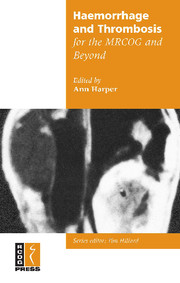Book contents
- Frontmatter
- Contents
- About the authors
- Abbreviations
- Preface
- 1 The coagulation system in pregnancy
- 2 Pregnancy in women with inherited bleeding disorders
- 3 Maternal and fetal thrombocytopenia
- 4 Massive obstetric haemorrhage
- 5 Disseminated intravascular coagulation
- 6 Gynaecological problems in women with bleeding disorders
- 7 Venous thromboembolism in obstetrics and gynaecology
- 8 Genetic thrombophilias and antiphospholipid antibodies
- Index
7 - Venous thromboembolism in obstetrics and gynaecology
Published online by Cambridge University Press: 05 October 2014
- Frontmatter
- Contents
- About the authors
- Abbreviations
- Preface
- 1 The coagulation system in pregnancy
- 2 Pregnancy in women with inherited bleeding disorders
- 3 Maternal and fetal thrombocytopenia
- 4 Massive obstetric haemorrhage
- 5 Disseminated intravascular coagulation
- 6 Gynaecological problems in women with bleeding disorders
- 7 Venous thromboembolism in obstetrics and gynaecology
- 8 Genetic thrombophilias and antiphospholipid antibodies
- Index
Summary
Venous thromboembolism (VTE) describes thrombotic events that occur in the venous circulation, encompassing primary thrombosis and embolic events such as pulmonary embolism (PTE).
VTE is a common cause of morbidity and mortality. Thromboses most commonly occur in the deep veins of the lower limbs (DVT), but can arise at other sites such as the upper limbs or mesenteric vessels. DVT may go unrecognised before presentation with PTE. In people hospitalised after trauma, surgery or immobilising medical illness, the risk of VTE is increased ten-fold, and PTE is a significant cause of death. Pulmonary embolism remains the leading cause of direct maternal death in the UK.
Following a treated DVT, over 60% of women have objectively confirmed deep venous insufficiency, and almost 80% will develop post-thrombotic syndrome. The odds ratio for developing venous insufficiency after a DVT has been estimated at 10.9 (95% CI 4.2–28.0) compared with 3.8 (95% CI 1.2–12.3) after a PTE. The difference may be due to thrombus clearing from the legs in PTE, leading to less extensive damage to the deep venous system. Other long-term effects of DVT include a significant risk of recurrent thrombosis, restriction of contraceptive choice and complications of anticoagulant therapy, while PTE carries a risk of subsequent pulmonary hypertension.
Epidemiology
VTE occurs in approximately 0.1% of pregnancies, with a two-fold increase in risk for those over the age of 35 years. The CEMD indicates that the incidence of fatal PTE has fallen substantially from the early 1950s.
Keywords
- Type
- Chapter
- Information
- Haemorrhage and Thrombosis for the MRCOG and Beyond , pp. 90 - 110Publisher: Cambridge University PressPrint publication year: 2005

